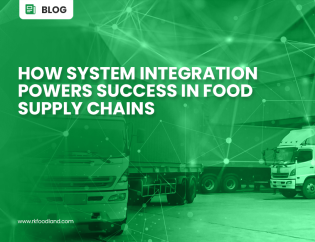
While many food supply chain experts are contemplating what they want to bring to the new year and what they’re ready to leave behind, here are ten resolutions to assist food brands in developing the supply chains of the future.
1. Plan and Play Smart
The pandemic showed us the fragility of the supply chains. Food brands reinvented their business models and went online to serve their customers. They had to find a way that required to address the fluctuations in demand and supply. Supply chains need real-time visibility to plan scenarios, optimize inventories, be pro-active to change and to make decisions. 55.73% of supply chain professionals are willing to invest in production planning and demand forecasting according to research by finance online in 2021. Integrated Demand Planning ensures real-time supply chain planning from sales and operations planning to forecast, demand response.
2. Invest in Employee Safety
Workplace health and safety policies help firms grow by retaining productive and qualified employees. It also provides a contingency plan for workforce assurance that can otherwise cause supply chain disruptions. Every organization must prioritize its people in order to maintain consistent growth. According to data provided by the Occupational Safety and Health Administration, employers who establish employee safety programs are able to reduce costs related to injury and workplace illness costs by 20 to 40 percent. The key to ensuring worker safety is to minimize hazards and providing an environment that places high importance to healthy practices and enabling employees to easily avail medical facilities.
3. Gain visibility to strengthen the value chain
According to a survey covered by finance online, 40.02% of supply chain professionals want to invest in real-time supply chain visibility. Having visibility across the entire supply chain helps businesses to understand and convey information seamlessly both internally and externally. To achieve 360-degree real-time visibility, extended communication and collaboration network between departments, third-party providers and manufacturers can help firms improve process transparency, make quick decisions, and increase customer satisfaction. Collaboration is the key to strengthen supply chain visibility.
4. Contribute towards a sustainable world
Businesses have acknowledged the value of environmentally friendly ecosystems. This means designing biodegradable products and packaging, sourcing resources responsibly from social and humanitarian groups, ensuring minimal waste and environmental impact, reducing mileage, emissions, and carbon footprint through logistics along with operating assets and equipment in an environmentally and worker-friendly manner. Sustainability necessitates cross-partner collaboration and strong visibility. To keep up with the changes, firms need a sustainable partner that can collaborate in building this ecosystem across the supply chain.
5. Introduce automation to the supply chain
The food supply chain generates a lot of data that can be used to improve operations and the customer experience. AI is designed to handle complicated processes quickly, such as inventory and route. With AI projecting future demand, food brands can better match demand with capacity, lowering the cost of shortages and overages. Machine Learning can improve demand planning by increasing forecast accuracy. This will help Food brands optimize inventories and minimize safety stock, increasing cash flow.









